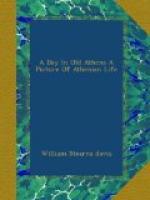173. Some Features of the Attic Country.—Postponing our examination of Athenian farmsteads and farming methods until we reach some friendly estate, various things strike us as we go along the road. One is the skilful system of irrigation,—the numerous watercourses drawn especially from the Cephisus, whereby the agriculturists make use of every possible scrap of moisture for the fields, groves, and vineyards. Another is the occasional olive tree we see standing, gnarled and venerable, but carefully fenced about; or even (not infrequently) we see fences only with but a dead and utterly worthless stump within. Do not speak lightly of these “stumps,” however. They are none the less “moriai”—sacred olive trees of Athena, and carefully tended by public wardens.[*] Contractors are allowed to take the fruit of the olive trees under carefully regulated conditions; but no one is allowed to remove the stumps, much less hew down a living tree. An offender is tried for “impiety” before the high court of the Areopagus, and his fate is pretty surely death, for the country people, at least, regard their sacred trees with a fanatical devotion which it would take long to explain to a stranger.
[*]Athenians loved to dwell on the “divine gift” of the olive. Thus Euripides sang ("Troades,” 799):—
In Salamis, filled with the foaming
Of billows and murmur
of bees,
Old Telamon stayed from his roaming
Long ago, on a throne
of the seas,
Looking out on the hills olive laden,
Enchanted, where first
from the earth
The gray-gleaming fruit of the Maiden
Athena had birth.
—Murray, translator.
The hero Telamon was reputed an uncle of Achilles and one of the early kings of Salami.
Also upon the way one is pretty sure to meet a wandering beggar—a shrewd-eyed, bewhiskered fellow. He carries, not a barrel organ and monkey, but a blinking tame crow perched on his shoulder, and at every farmstead he halts to whine his nasal ditty and ask his dole.
Good people, a handful of barley bestow
On the child of Apollo, the sleek sable crow;
Or a trifle of whet, O kind friends, give;—
Or a wee loaf of bread that the crow may live.
It is counted good luck by the housewife to have a chance to feed a “holy crow,” and the owner’s pickings are goodly. By the time we have left the beggar behind us we are at the farm whither our excursion has been tending.
174. An Attic Farmstead.—We are to inspect the landed estate of Hybrias, the son of Xanthippus. It lies north of Athens on the slopes of Anchesmus, one of the lesser hills which roll away toward the marble-crowned summits of Pentelicus. Part of the farm lands lie on the level ground watered by the irrigation ditches; part upon the hillsides, and here the slopes have been terraced in a most skilful fashion in order to make the most of every possible inch of ground, and also to prevent any of the precious




